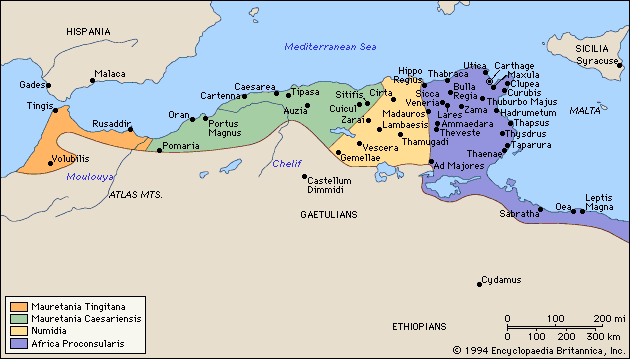
Numidia
Under the Roman Republic and Empire, a part of Africa north of the Sahara, the boundaries of which at times corresponded roughly with those of modern Algeria. Its earliest inhabitants were divided into tribes and clans and were physically indistinguishable from the other Berber inhabitants of early North Africa. From the 6th century B.C. points along the coast were occupied by the Carthaginians, who by the 3rd century B.C. had expanded into the interior as far as Theveste (Tébessa). Numidians were frequently found in the Carthaginian armies by that time.
The inhabitants remained seminomadic, however, until the reign of Masinissa, the chief of the Massyli tribe living near Cirta (Constantine). During the Second Punic War he was initially an ally of Carthage, but he went over to the Roman side in 206 B.C. and was given further territory extending as far as the Mulucha (Moulouya) River. For nearly 50 years Masinissa retained the support of Rome as he tried to turn the Numidian pastoralists into peasant farmers. He also seized much Carthaginian territory and probably hoped to rule all of North Africa.

On his death in 148 B.C. the Romans prudently divided his kingdom among several chieftains, but the progress of civilization among the Numidians was not seriously interrupted, and indeed after 146 B.C. it received new impetus as thousands of Carthaginians fled to Numidia after the destruction of Carthage. In 118 Jugurtha, an illegitimate Numidian prince, usurped the throne and forcibly reunified Numidia until the Romans again took control in 105. Rome continued to dominate Numidia through client kings, though Numidian territory was considerably reduced. The third and final attempt by a Numidian to found a powerful state was that of Juba I, between 49 and 46 B.C., ending with his defeat by Julius Caesar at Thapsus.
Caesar formed a new province, Africa Nova, from Numidian territory, and Augustus united Africa Nova ("New Africa") with Africa Vetus ("Old Africa," the province surrounding Carthage); but a separate province of Numidia was formally created by Septimius Severus.
The Roman army's third legion took up its permanent station at Lambaesis (Lambessa), and as a result of the increased security the Numidians' population and prosperity increased substantially during the first two centuries A.D. A few native communities achieved municipal status, but the majority of the population was little touched by Roman civilization.
Christianity spread rapidly in the 3rd century A.D., but in the 4th century Numidia became the centre of the Donatist movement. This schismatic Christian group was particularly strong among the Numidian peasantry, to whom it appealed as a focus of protest against deteriorating social conditions. After the Vandal conquest (A.D. 429), Roman civilization declined rapidly in Numidia, and the native elements revived to outlive in some places even the Arab conquest in the 8th century and to persist until modern times. (Encyclopaedia Britannica Article)